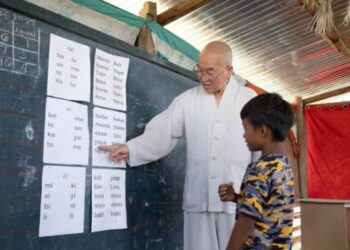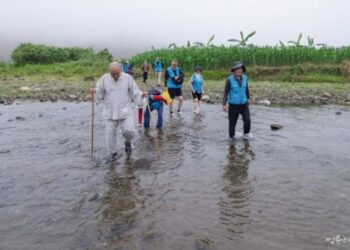May 15, 2025. 88th Day of the 100-Day Dharma Talk, Teacher’s Day, Heart Sutra Lecture 6, Buddhist Social Studies Course Lecture 19
Hello. Today is the 88th day of Venerable Pomnyun Sunim’s 100-Day Dharma Talk. Today features both a sutra lecture and a Buddhist Social Studies Course lecture.
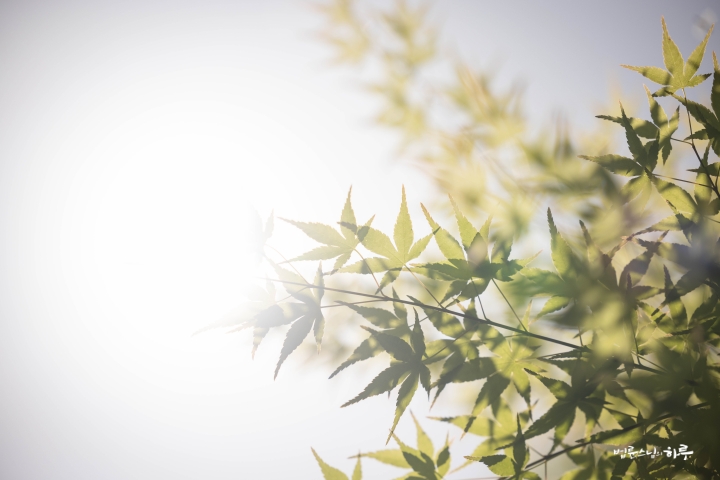
After completing his morning practice and meditation, Sunim headed to the Jungto Social and Cultural Center to give the sutra lecture.
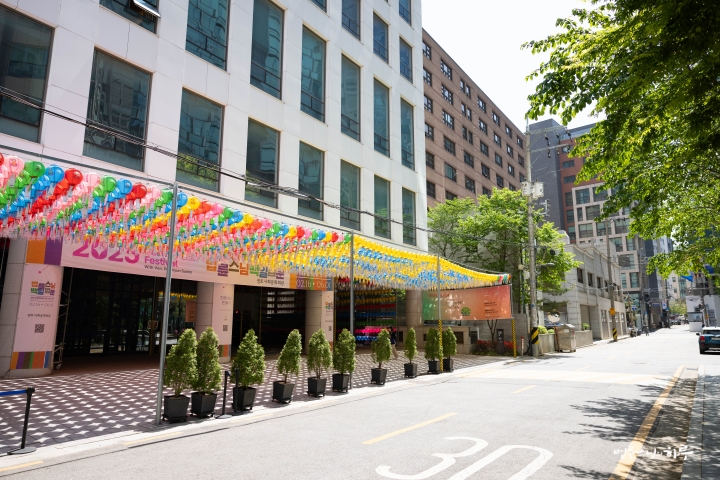
About 110 people gathered in the third-floor Dharma Hall, while approximately 560 people joined the live online broadcast. Today, in celebration of Teacher’s Day, a special ceremony was held before the lecture to express gratitude to Sunim.
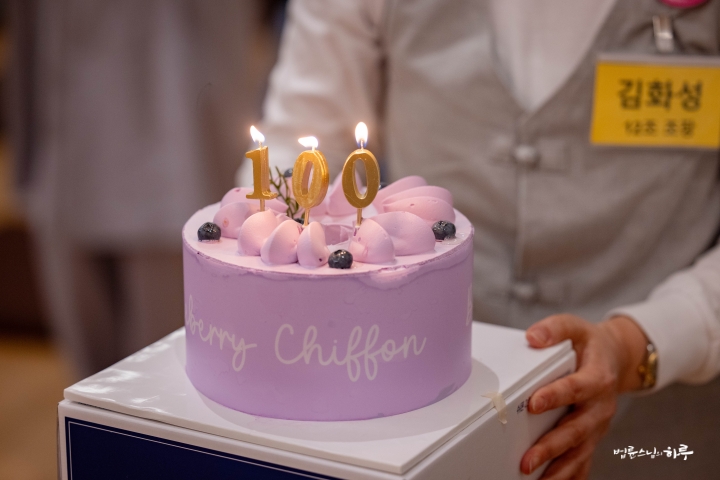
First, the Seoul branch of the Community Division presented a congratulatory performance. Six people came forward holding signs and shouted:
“We can’t live because of polarization, inequality, discrimination, stress, anxiety, war, climate crisis, and natural disasters!”
“Everyone, don’t worry. We have Venerable Pomnyun Sunim!”
They then performed an energetic dance to Girls’ Generation’s “Way to Go.”
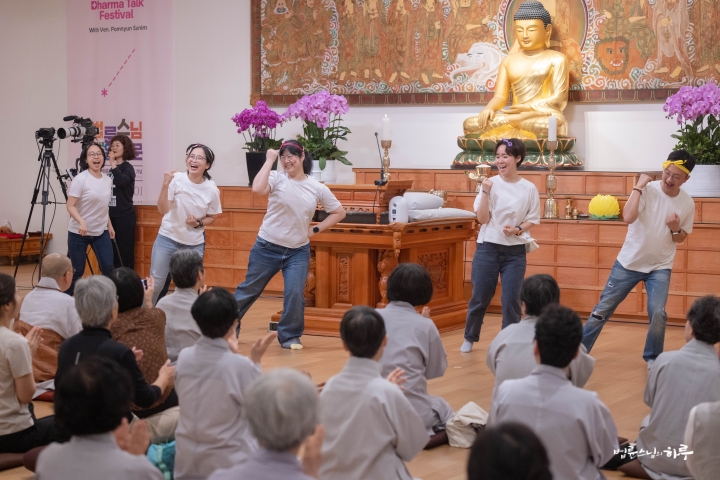
Next, the “Young Buddha” team, who have been living and practicing in the community during this 100-Day Dharma Talk period, presented their congratulatory performance. They expressed AKMU’s “Give Love” with amusing dance movements. The young people concluded their performance with heart gestures.
“Venerable Pomnyun Sunim, we love you.”
Sunim smiled broadly while watching his disciples’ performances.
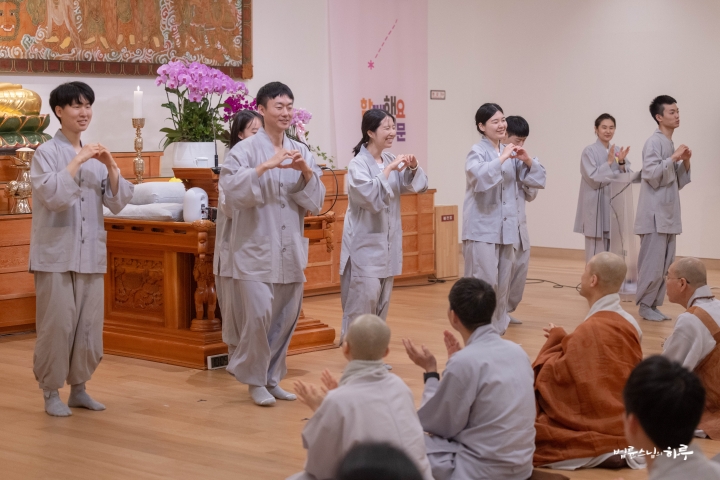
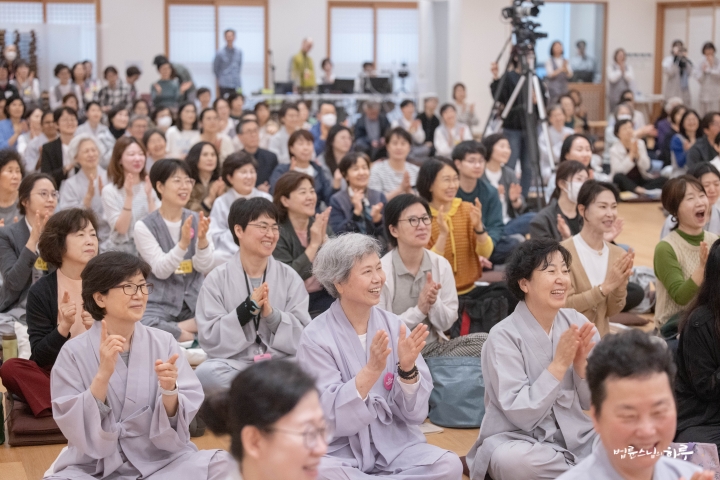
Then, the entire assembly performed three full bows to Sunim to express their gratitude.
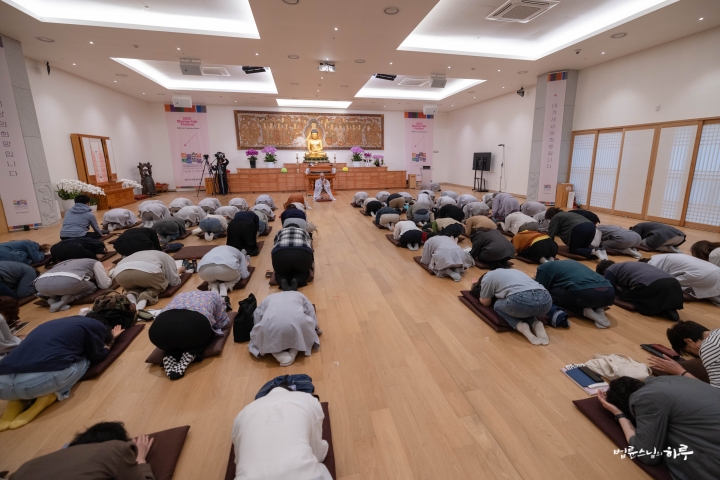
Next, Ms. Jegal, representing the sutra lecture students, presented Sunim with a bouquet of flowers and read a letter of appreciation.
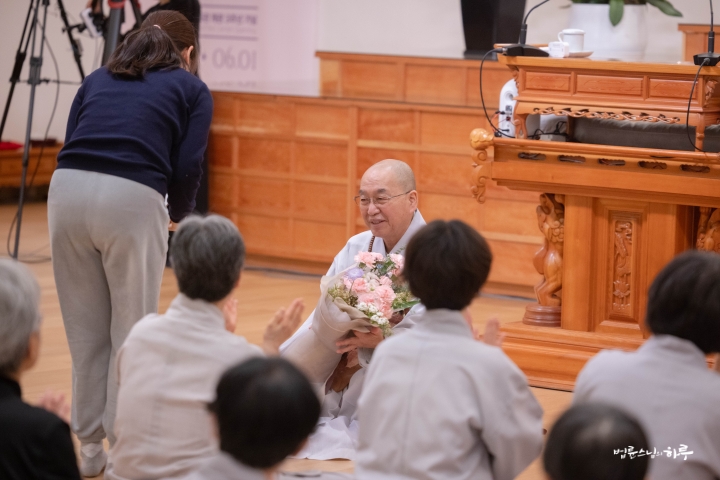
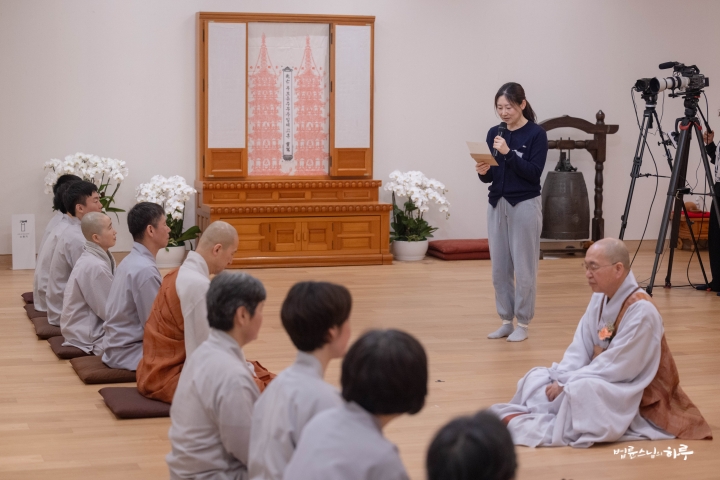
“As the 100-Day Dharma Talk approaches its end, I feel both gratitude and regret. I am thankful for this opportunity to express my feelings through this handwritten note on Teacher’s Day. With each lecture, I experience my doubts being resolved, my concerns being addressed, and my suffering diminishing. After listening to Venerable Pomnyun Sunim’s explanation of the Diamond Sutra and then reading it again, the text felt alive to me. I am grateful that the Buddha’s teachings have reached me, and I am thankful for this moment when I can listen to Sunim’s Dharma talks. Based on this experience, I will move toward a life without suffering, cherish the value of the Buddha’s teachings, and contribute what little strength I have.”
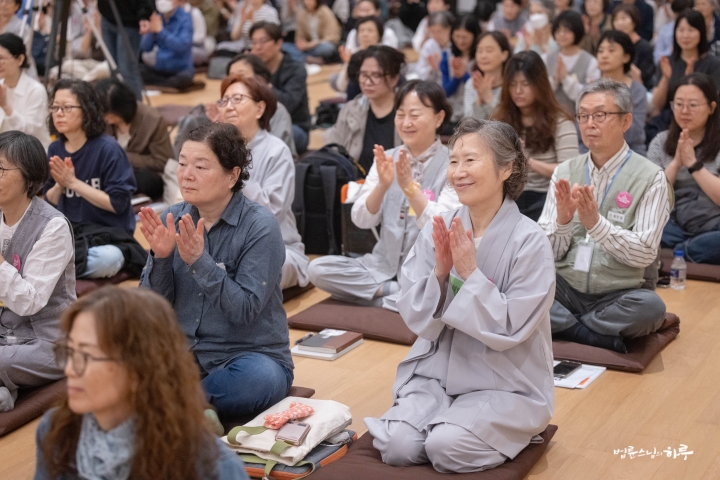
Next, everyone sang “Teacher’s Grace” together, expressing sincere gratitude to Sunim for his profound teachings throughout the 100 days.
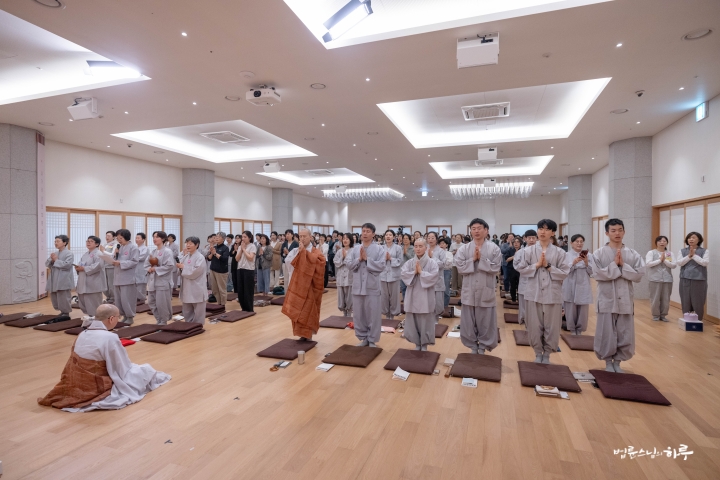
♬ The grace of a teacher is like the sky ♬
The more we look up, the higher it seems
Teaching us to be truthful and righteous
The teacher is the parent of our minds
Ah, how grateful we are for the teacher’s love
Ah, we will repay the teacher’s grace ♬
Tears welled up in the eyes of those singing. After the song ended, everyone shouted together, expressing everyone’s feelings:
“Sunim, thank you. Sunim, we love you.”
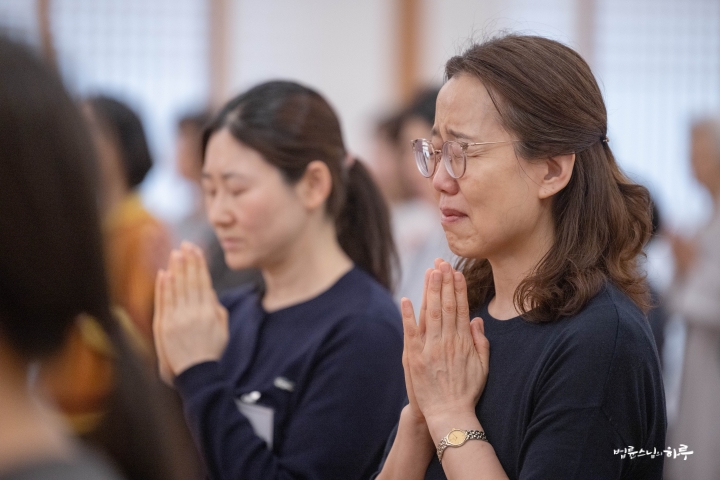
Finally, when Sunim blew out the candles on the cake, everyone applauded to convey their congratulations.
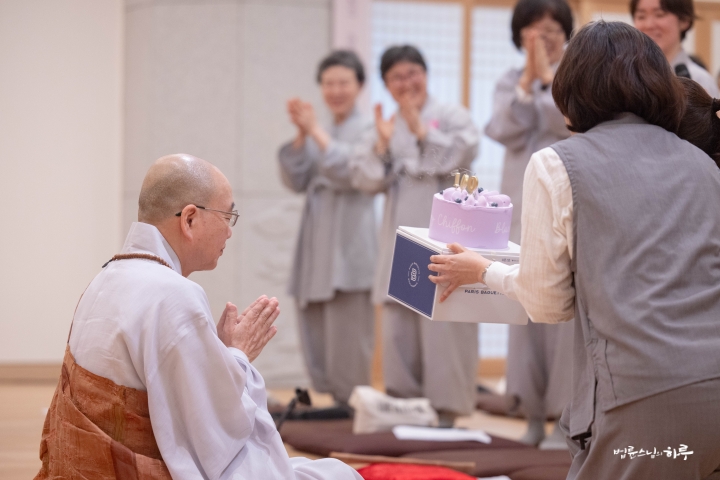
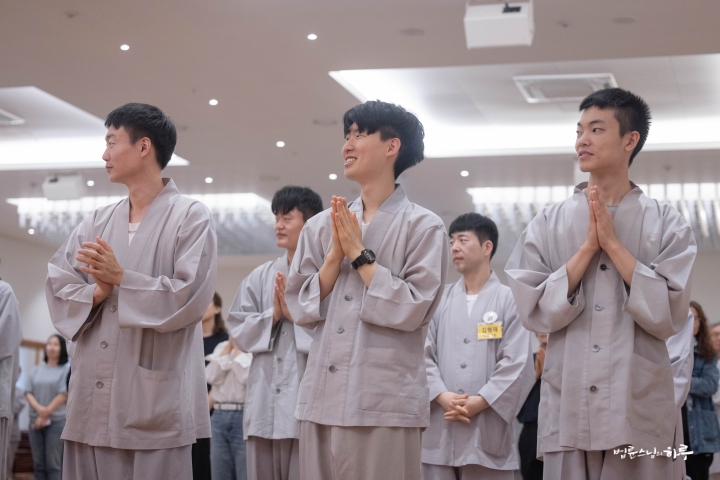
After taking a moment to calm their minds, the sutra lecture began. When the assembly requested the Dharma talk with three bows, Sunim ascended to the Dharma seat.
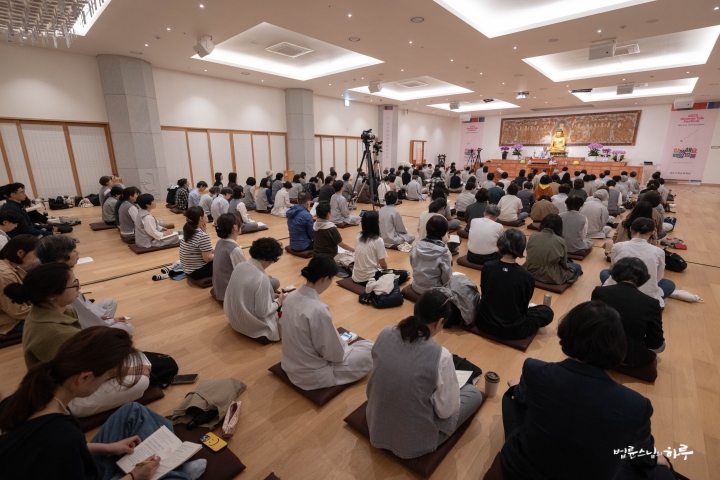
After briefly summarizing the content learned in previous sessions, Sunim continued with the sixth lecture on the Heart Sutra.
“The path to liberation from all suffering through awakening is called ‘Prajnaparamita.’ This is not a path of liberation through belief or knowledge, but through awakening. For example, when being chased by a robber in a dream, you don’t escape by running away, asking Avalokitesvara Bodhisattva for help, or by fighting and defeating the robber. Only by waking up from the dream can you completely escape from the robber. Similarly, the practice of Prajnaparamita is the path to complete liberation from suffering through awakening.

The Path to Liberation from Suffering Through Awakening
Avalokitesvara Bodhisattva, through the practice of Prajnaparamita, realized the emptiness of all phenomena and was liberated from all suffering. All bodhisattvas also cut off deluded thoughts through this practice and reached final nirvana. All the Buddhas of the past also attained Anuttara Samyak Sambodhi, the supreme enlightenment, through this Prajnaparamita. Therefore, Prajnaparamita can be considered the greatest practice.
That’s why the following passage expresses the greatness of Prajnaparamita in four ways.
“Is the great miraculous mantra” (是大神咒) means it is the most mystical mantra; “is the great bright mantra” (是大明咒) means it is the brightest mantra; “is the supreme mantra” (是無上咒) means it is the highest mantra; and “is the incomparable mantra” (是無等等咒) means it is a mantra beyond comparison. In other words, there is no mantra more mystical, bright, high, or great than this. Here, “mantra” is a translation of “dharani,” which refers to “true words” (眞言) meaning “truthful” or “true speech.”
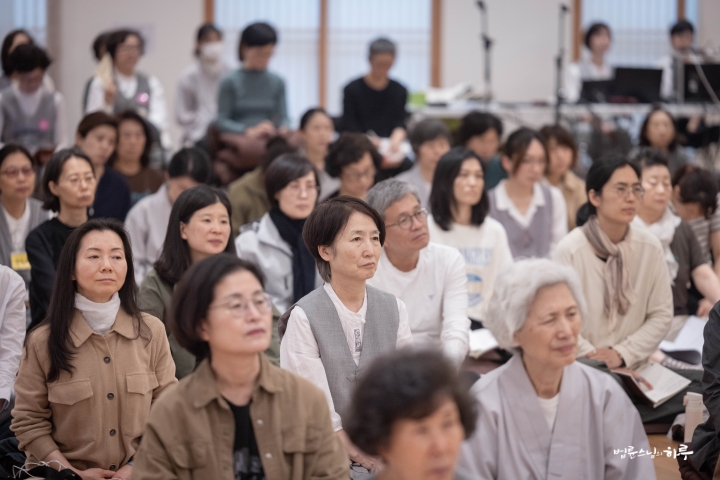
Why is Prajnaparamita the Greatest Mantra?
First, a mystical mantra is one that is believed to create miracles when recited. Miracles don’t happen simply because one possesses a lot of knowledge. Miracles arise from deep, sincere faith. Let me share an old story as an example. When parents fall ill with no signs of recovery, their children visit a doctor as a last hope. The doctor tells them, “This illness can only be cured with a 100-year-old wild ginseng or a flower that blooms in the snow.” These are nearly impossible tasks in reality. Nevertheless, the children leave home with desperate hearts. In these stories, it’s often not the eldest son or the one with the greatest responsibility who succeeds, but rather the youngest child or the daughter who steps forward. They embark on their journey with sincere determination. This is something that cannot be done without faith. When such desperate faith exists, miracles can happen.
This is why religions often emphasize such miraculous cases. Stories abound of people diagnosed with terminal cancer and given only months to live, who recover after going to a temple and earnestly praying to Avalokitesvara Bodhisattva, or those who overcome illness through prayer at church, or survive after praying to Ksitigarbha Bodhisattva or mountain spirits. When people recover and survive in such ways, their faith deepens tremendously. When speaking with doctors, they mention that very rarely, cancer can disappear naturally without specific treatment. It’s an extremely rare case—perhaps one in a thousand—but there are actual instances where terminal cancer patients experience spontaneous remission. If such a person had turned to religion with desperate faith after receiving a terminal diagnosis, this natural healing experience would lead to profound faith. As the saying goes, “When a person’s heart is sincere, heaven is moved.” The phrase “the most mystical mantra” in reference to Prajnaparamita suggests that it can create even greater miracles than any other desperate faith.
Second, what does it mean to be “the brightest mantra”? When someone knows something well, we say they are “clear” or “bright” about that matter. Similarly, in the phrase “the great bright mantra” (시대명주/是大明咒), “bright” (명/明) means “to know clearly.” When Prajnaparamita is described as the brightest mantra, it means that no matter what knowledge one might possess in this world, Prajnaparamita represents an understanding that is brighter than any other knowledge.
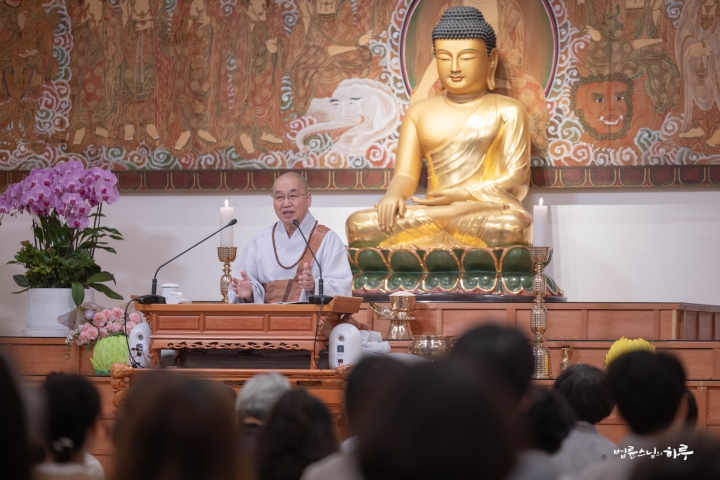
Third, what does it mean to be the highest mantra? When we practice something, we often establish stages. For example, when asked, “What degree of Taekwondo do you have?” one might answer, “Sixth degree” or “Seventh degree.” We constantly create such hierarchical distinctions. The phrase “시무상주” (是無上咒) means that Prajnaparamita is beyond any level that can be reached through all practical actions in the world. It means there is no higher level beyond it.
Fourth, “시무등등주 (是無等等咒) means it is the most excellent mantra, incomparable to anything in this world. When we master and attain a certain state, we often compare it with other things. However, this mantra not only has nothing higher but also has nothing that can even be considered similar to it.
These four aspects can be expressed differently as “faith, understanding, practice, and realization” (信解行證). Faith (信) means belief, understanding (解) means comprehension, practice (行) means implementation, and realization (證) means attainment. To progress toward truth, first, we need faith. Without faith, we become easily shaken. Second, understanding is necessary. If we have faith without understanding, it can easily become superstition or blind faith. Faith is important, but foolish or misguided faith can bring tremendous adverse effects to the world, making it dangerous. So if there is faith without understanding, it tends to drift toward superstition or blind faith. Conversely, there are cases where understanding exists without faith. This is called “intellectual knowledge.” When someone reads many scriptures and knows a lot but lacks faith, action doesn’t follow easily. No matter how much one knows, it’s useless without action. Therefore, third, practice is important. However, even with diligent practice, the effect is minimal without experience. Even if one meditates for a long time without experiencing samadhi, the effect will inevitably be limited. Thus, fourth, realization—one’s own experience—is absolutely necessary.
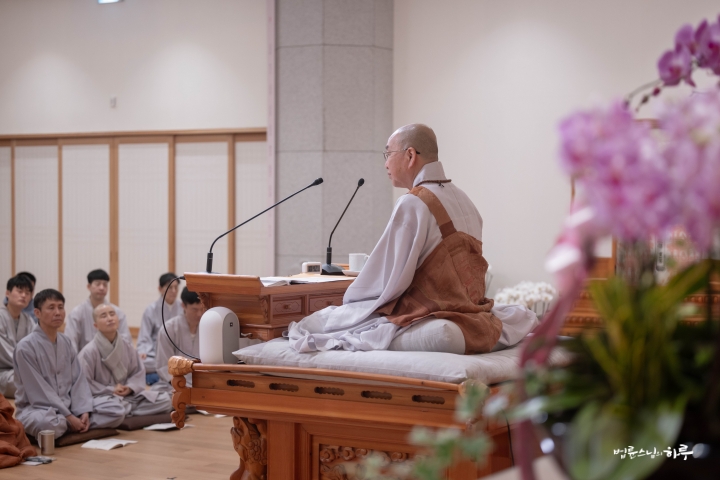
When verifying the truth, four stages are necessary: believing, understanding, practicing, and attaining. In Chinese characters, this is expressed as Sinhaehaengjeung (信解行證). When studying sutras, you should practice based on these four stages. First, you must have faith; second, you need a correct understanding of the principles; third, you must actually practice according to what you understand; and fourth, you must experience the effects for yourself.
The enlightenment gained through Prajnaparamita practice is a faith more solid than any other belief, a knowledge brighter than any other understanding, a practice higher than any other implementation, and an attainment incomparable to any other achievement. The text explains why Prajnaparamita practice is the most profound practice by comparing these four aspects of Sinhaehaengjeung.
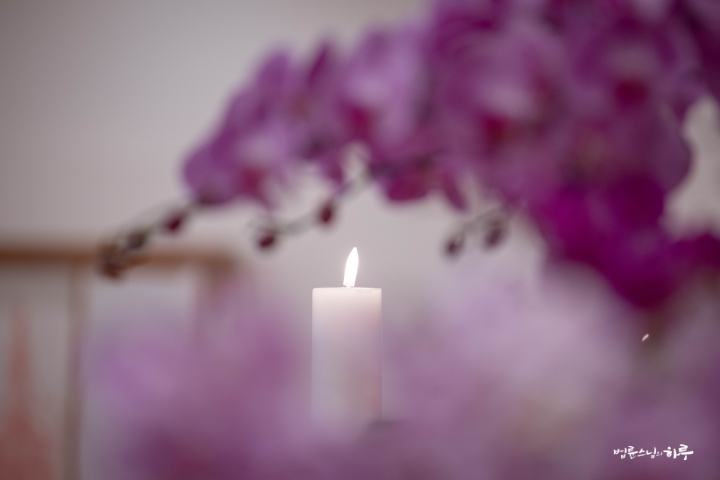
Now All That Remains Is to Act and Practice
Having understood all these principles, what remains? Only the actual practice. That’s why at the end of the Heart Sutra, it says, “Let’s go to the other shore.” This other shore represents the world of nirvana, the Pure Land, the realm of the Buddha. In other words, crossing to the other shore means attaining enlightenment. The essence is “Let’s become enlightened!” or “Let’s wake up from the dream!” No matter how many times we discuss various topics, it’s of no use; what’s most important is to open our eyes right now and wake up from the dream. The message is to stop wandering in dreams.
The final phrase, “Gate Gate Paragate Parasamgate Bodhi Svaha,” is a mantra, or dharani. The translator may have left this part untranslated, preserving the original sounds, perhaps thinking that translating it would weaken the ending, while everything else was translated. If you have accepted all the preceding content, all that remains is to actually cross to the other shore and attain enlightenment. Since the core philosophy of Prajnaparamita has been thoroughly explained earlier, rather than repeating its meaning at the end, a mantra follows that instills strong determination for the path ahead.
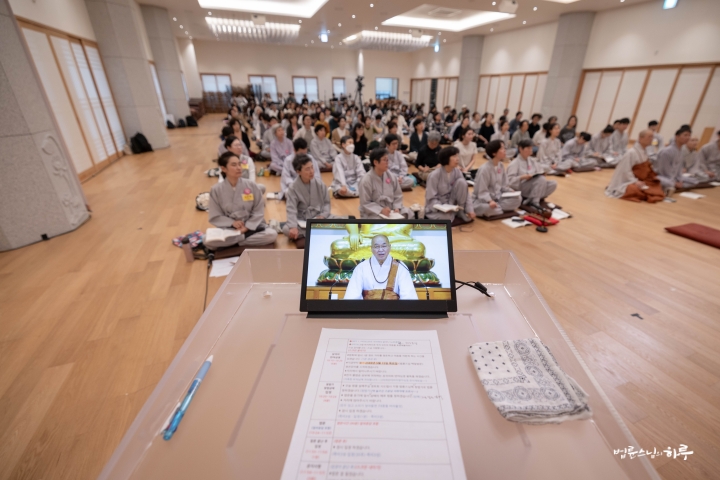
With this, Sunim completed the explanation of the entire Heart Sutra text. Everyone recited the Heart Sutra together from beginning to end, first in Chinese characters and then in Korean, before concluding the lecture.
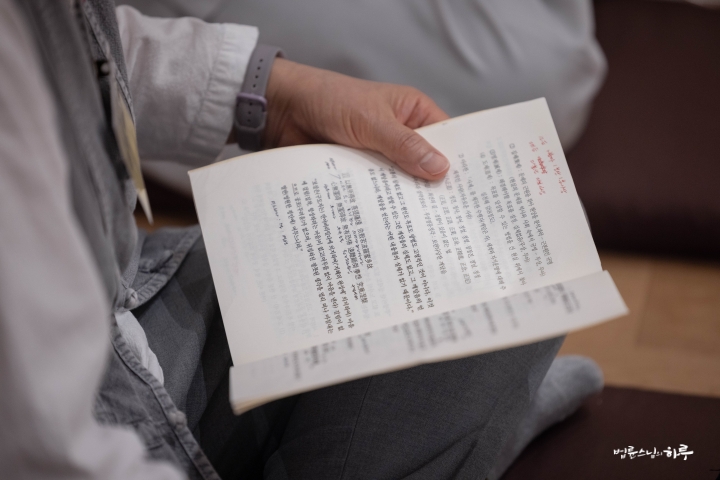
Participants gathered in groups for mindful sharing, while Sunim moved to the basement dining hall to have lunch with the Sangha members. In the afternoon, Sunim attended to office work and prepared for the evening Buddhist Social Studies Course lecture.
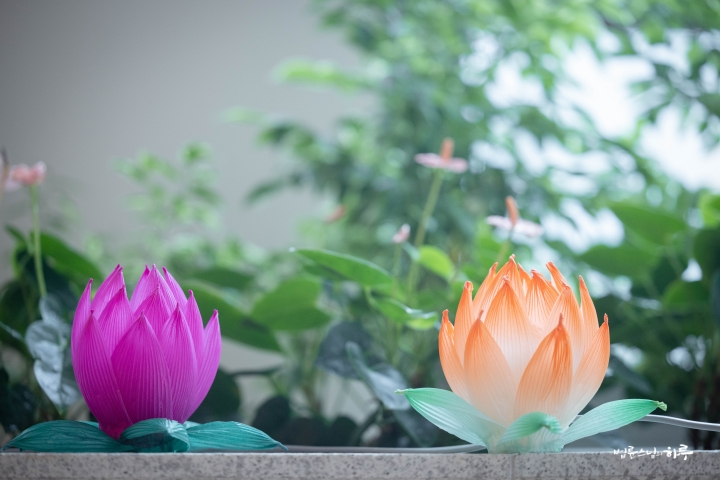
As the sun set, at 7:30 PM, Sunim delivered the 19th lecture of the Buddhist Social Studies Course in the main hall of the Jungto Social and Cultural Center basement. About 170 people attended in person, while approximately 1,900 people connected online.
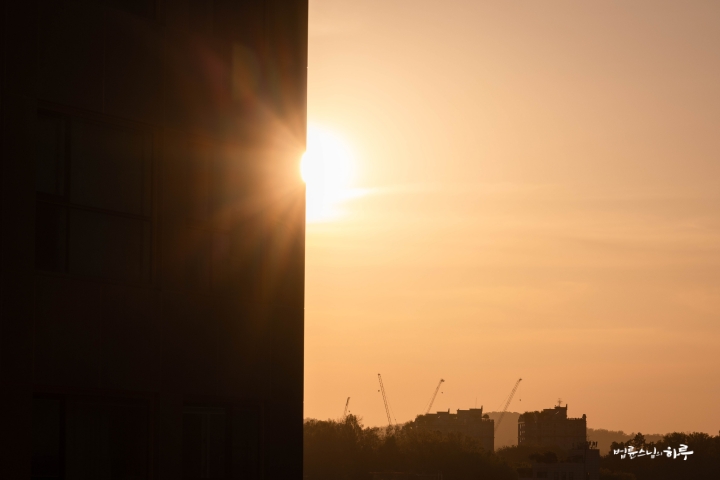
In the previous session, Sunim taught about Buddhist peace philosophy under the theme “Can We Change the World Through Peaceful Means?” Today, Sunim continued with the topic of “Buddhist Social Engagement.” While the 14th lecture had examined cases of Buddhist social engagement in Korean history, today’s lecture explored examples of Buddhist social engagement around the world.
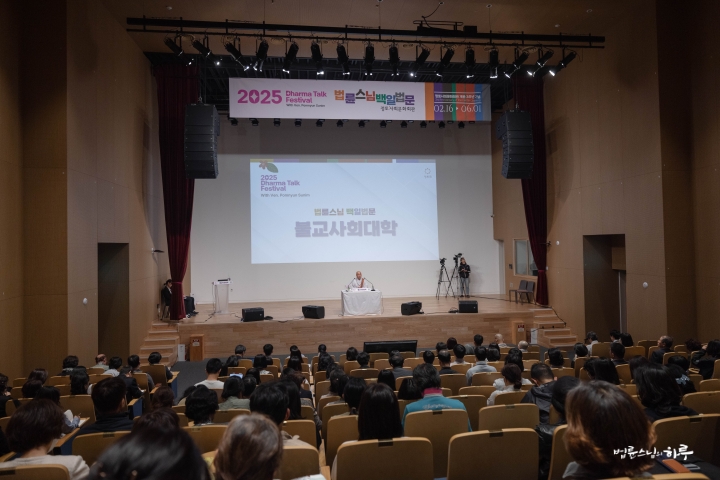
“Today, I would like to introduce figures who have carried out Buddhist social activism globally. Most of them initiated new Buddhist movements in the mid to late 20th century, after the end of World War II. First, we can mention Ambedkar of India as someone who greatly influenced global Buddhism through modern engaged Buddhist movements.”
Ambedkar’s Neo-Buddhist Movement to Eliminate Caste Discrimination
Ambedkar was a freedom fighter who was active during British rule in India. Though born into the untouchable caste, he studied extensively, learning law in England and the United States, and even earning a doctoral degree. He was deeply involved in India’s independence movement and is regarded as one of the two pillars of the independence movement alongside Gandhi. Gandhi believed that gaining independence from Britain was the most important priority during India’s independence movement. Therefore, he temporarily set aside the issue of caste discrimination in India. In contrast, Ambedkar argued that “without the abolition of caste discrimination, independence would be meaningless for the untouchables.” He insisted that after India’s independence, caste discrimination must be completely eliminated. Thus, he pursued both the independence movement and the movement to abolish caste discrimination simultaneously.
When the Indian government was established, Ambedkar’s efforts were highly recognized, and he became the first Minister of Law. He played a significant role in legally eliminating all caste and gender discrimination when the constitution was established. Even today, on Ambedkar’s birthday, untouchables travel by train to his sacred site in Nagpur. The Indian government allows untouchables to use third-class train seats for free on this day and has designated Ambedkar’s birthday as a national holiday, along with Gandhi’s birthday.
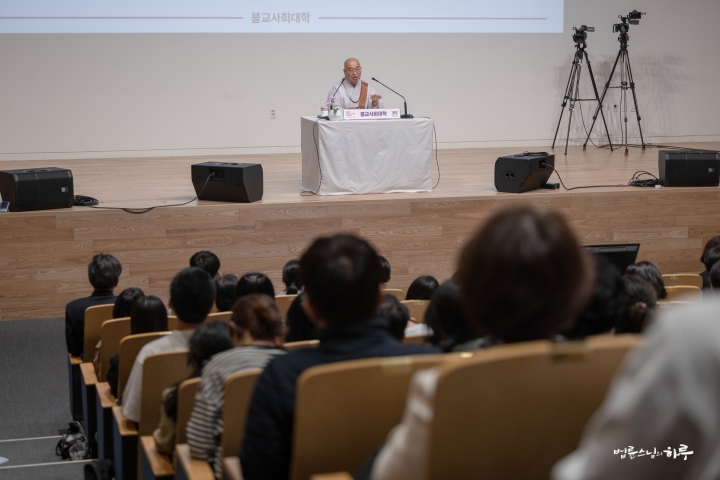
Ambedkar worked to eliminate the caste system, a class-based discrimination deeply rooted in Hindu tradition. Though born a Hindu, he resolved not to remain one until his death. However, converting to Christianity was not easy either, as it was the religion of the colonial ruler, Britain—a difficult choice for an independence activist. After much contemplation, Ambedkar began reading Buddhist scriptures extensively. He discovered that the Buddha was Indian and had already advocated for the elimination of all discrimination 2,600 years ago. This led Ambedkar to decide to become a Buddhist, and he converted from Hinduism to Buddhism three months before his death. Following his example, approximately 500,000 people from the untouchable caste converted to Buddhism. This movement, distinct from traditional Buddhism and known as the “Neo-Buddhist Movement,” holds great significance in India.
Most elements in Korean Buddhism today still contain traces of traditional Indian thought and culture. Concepts like reincarnation, karma, past lives, and stories of various deities known as Hwaeomseongjoong (華嚴聖衆) are examples of this influence. However, the Neo-Buddhist Movement rejected these traditional elements, claiming they were not part of the Buddha’s original teachings. They argued that Buddhism should rely solely on the Dhamma, the Buddha’s teachings. Their position was that even traditional cultures or religions should be rejected if they contained class discrimination. Thus, when Ambedkar converted to Buddhism, he simultaneously launched a movement for caste liberation. In some ways, embracing Buddhism was a means toward achieving caste liberation.
Tzu Chi Foundation, a Buddhist Movement Born from Compassionate Charity
Next is the Tzu Chi Foundation (慈濟功德會) from Taiwan. It’s called “Tzu Chi” in Chinese and “Jaje” in Korean. When China became communist and the Kuomintang government relocated to Taiwan, many Buddhist monks fled with them. While Korean Buddhism maintained its traditional sectarian structure, the monks who came from mainland China had lost their existing sectarian system. This led to new Buddhist movements developing based on the individual capabilities of each master. Four organizations—Fo Guang Shan Monastery (佛光山寺), Tzu Chi Foundation, Dharma Drum Mountain (法鼓山寺), and Chung Tai Chan Monastery (中臺禪寺)—form the central pillars of Taiwanese Buddhism today. Fo Guang Shan, in particular, has grown to become the largest and most representative organization, engaging in various activities including charity work. However, while Fo Guang Shan has modernized to some extent, it still maintains a traditional Buddhist belief system, making it difficult to consider it a completely new Buddhist movement.
Tzu Chi, however, can be considered a new Buddhist movement distinct from traditional ones. This movement was initiated by a bhikkhuni named Master Cheng Yen. Initially, she had no sponsors or foundation. The nun built a small hut for practice and made a living by selling candles with her disciples. Though starting very modestly, she based her practice on one of the central concepts of Mahayana Buddhism: the Four Immeasurables (四無量心). These Four Immeasurables refer to boundless states of mind: Loving-kindness (慈) is love, Compassion (悲) is empathy for those who suffer, Sympathetic Joy (喜) is rejoicing in others’ happiness, and Equanimity (捨) is treating all people equally. The spirit of the Four Immeasurables emphasized the importance of practicing these four states of mind—love, compassion, joy, and equality—in daily life.”
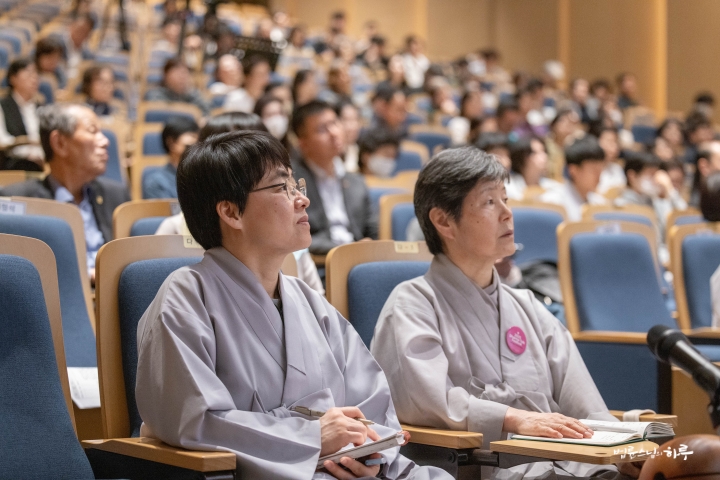
Continuing, Sunim provided a detailed introduction to the various charitable activities conducted by the Self-Reliance Foundation. He then introduced different figures who initiated new Buddhist movements, including the Santi Asoke Movement in Thailand, the Dalai Lama, Thich Nhat Hanh, Venerable Gosananda’s peace movement, and Sulak Sivaraksa’s Engaged Buddhist Network.
The Santi Asoke Movement: A Buddhist Movement Practicing Non-Possession and Simple Living
“Next, there was a Buddhist movement that emerged in Thailand. Thailand is a representative Buddhist country. In this country, there are three things that cannot be criticized. First, you cannot criticize the royal family. Second, you cannot criticize the military because it belongs to the king. Third, you cannot criticize the Sangha. In Thailand, all temples are owned by the state. Since the king has the authority to appoint temple abbots, Thailand’s Buddhism is a unified ‘state Buddhism’ system. In Thailand, which maintains a feudal monarchy system, both the military and the Sangha can be seen as connected to the king as one.
This is why there are criticisms that high-ranking monks in Thailand live luxuriously and corruption is severe. Deeply disappointed by this reality, a young monk named ‘Buddhadāsa’ let go of all worldly things, went into the forest, and devoted himself to meditation and practice. Reading early scriptures in Pali, he criticized aspects of Thai Buddhism that contradicted these teachings. Among Buddhadāsa’s disciples influenced by him were Sulak Sivaraksa and a person named Chamlong, who was once the mayor of Bangkok. Buddhadāsa’s philosophy and practice became the philosophical foundation for reinterpreting Buddhism and the basis for various new Buddhist movements emerging in Thai society. Among them is the ‘Santi Asoke Movement.’ The core of this movement is to return to the Buddha’s original teachings. It is a new practice community movement that abandons the luxurious life and corruption that monks have enjoyed, practices non-possession and simple living, does not accept donations, and pursues a self-reliant and communal life.
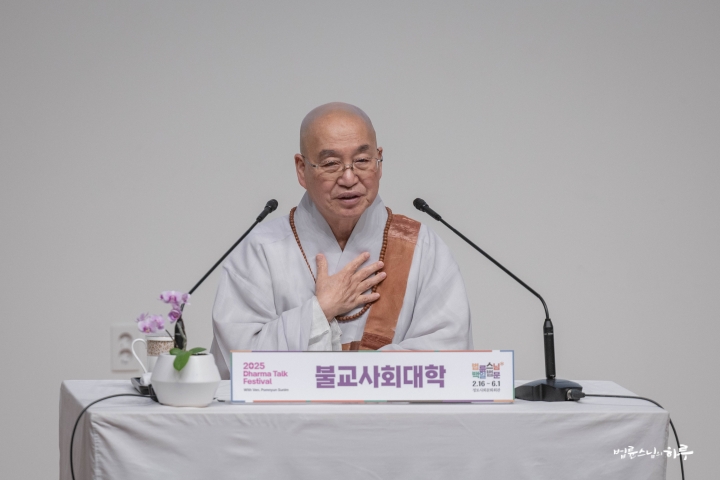
Dalai Lama, Thich Nhat Hanh, Maha Ghosananda… Monks Who Called for Peace in the Face of Death and Massacre
Next is the peace movement. There are three prominent figures representing the peace movement: the Dalai Lama, Thích Nhất Hạnh, and Maha Ghosananda. All three experienced the tragedy of their homelands being devastated by war. The eldest among them, Venerable Ghosananda, was from Cambodia. During the Vietnam War, Cambodia was also drawn into the conflict, and later, when the Pol Pot regime came to power, horrific massacres occurred. Even after the regime collapsed, the cycle of revenge continued. Amidst these terrible circumstances, Venerable Maha Ghosananda led a non-violent peace movement.
Vietnam also suffered tremendous damage during its civil war. There, Venerable Thich Nhat Hanh practiced the peace movement. Tibet was invaded by the People’s Republic of China, which eventually forced the Dalai Lama to flee to India. Inside Tibet, nationalist resistance movements emerged, followed by massacres carried out by the communist government. When people experience such wars and massacres, they naturally demand armed resistance. The same happened in Korea. The March 1st Movement of 1919 began as a non-violent peace movement, but after experiencing brutal massacres, it transformed into armed resistance with guns and swords by 1920. However, these three monks share the common trait of practicing peace movements according to Buddhist teachings despite such harsh realities.
Dr. Ariyaratne, Founder of the Sarvodaya Movement of Collective Awakening
Next is Dr. Ariyaratne, a Buddhist activist from Sri Lanka, which was once a British colony. Dr. Ariyaratne initiated a village development movement at the grassroots level, similar to Korea’s Saemaul Movement. While the Saemaul Movement was government-led, this movement was entirely voluntary and civilian-driven. The Sarvodaya Movement that he founded pursues collective awakening of the community rather than individual enlightenment. The Sarvodaya Movement was so successful that at one point, about one-third of all villages in Sri Lanka achieved development with its help, and Dr. Ariyaratne became so well-known that he was recommended as a presidential candidate. Without receiving support from anyone, he led a movement not simply for economic prosperity but for collective awakening. He established village banks and kindergartens in each village, contributing to village development. In other words, he implemented grassroots village development.
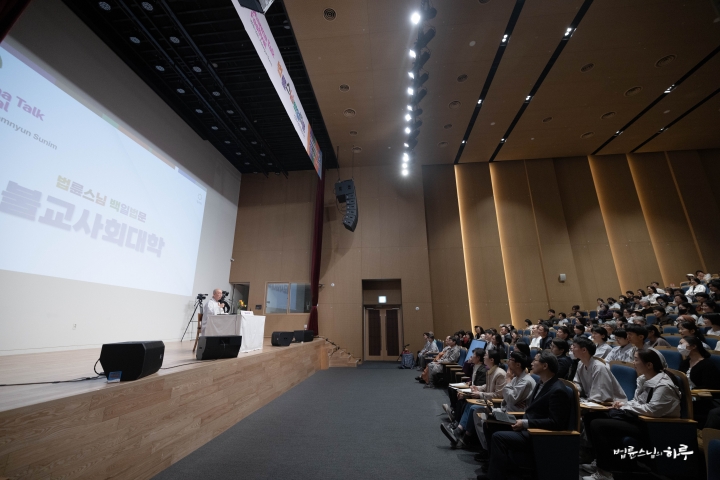
Connecting the World Through Buddhism: Dr. Sulak Sivaraksa’s Engaged Buddhism
Next is Sulak Sivaraksa. He is a disciple of Buddhadāsa and earned his doctorate in economics in England after studying Buddhism. He primarily advocated Buddhist economics. Since Buddhism is inherently distant from capitalism, his perspective sometimes takes on characteristics of Buddhist socialism. He established the International Network of Engaged Buddhists (INEB). Five advisors participated in INEB: the Dalai Lama, Gosananda, Ariyaratne, Thich Nhat Hanh, and Sulak Sivaraksa. In the 1990s, these individuals spread a new Buddhist movement worldwide that went beyond traditional faith-centered Buddhism to emphasize social engagement and practice. Sulak Sivaraksa leads this network, conducting various educational movements in different countries and guiding the solidarity of engaged Buddhism. Currently, the engaged Buddhist network is expanding as a solidarity organization for people practicing engaged Buddhism in various countries. Jungto Society is also a member of INEB and participates in various solidarity activities.
Parliament of the World’s Religions: A Forum for Interfaith Peace Movements
Next, though not specifically Buddhist, is the Parliament of the World’s Religions. This gathering brings together not only Buddhists but various religions from around the world to discuss peace, the environment, and the future of civilization. In 1871, a great fire in Chicago burned down almost the entire city. To comfort and encourage those who suffered from this disaster, the first Parliament of the World’s Religions was held in Chicago in 1893. One hundred years later, in 1993, the second Parliament was held again in Chicago, where I participated and began interacting with figures like the Dalai Lama, Thich Nhat Hanh, Sulak, and Ariyaratne. Beyond Buddhist practices, various global movements are taking place through interfaith cooperation, and smaller-scale experiments continue in many places. Perhaps Jungto Society can also be seen as an experiment attempting to develop a new form of Buddhism within Korea.
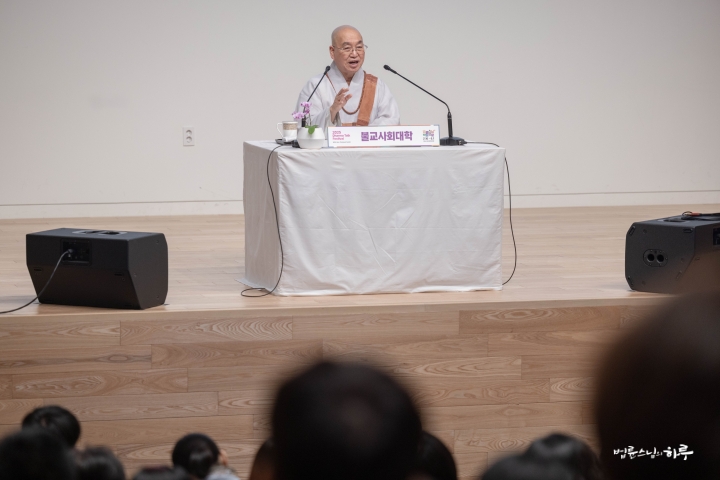
How Can Buddhism Transcend the Limitations of Modern Civilization?
For a movement to be considered a new Buddhist movement, it must meet several criteria. First, it must have an awareness of the need to find alternatives to overcome the limitations of modern civilization. Modern material civilization, which can be called capitalist civilization, has reached its limits. It is not sustainable. Therefore, there must be an awareness of the question, “What is the alternative?” Buddhist movements begin anew from this awareness. That’s why people involved in this movement consider environmental issues important. When this awareness combines with Buddhist teachings, it leads to practices that reduce consumption and embrace a simpler lifestyle. Additionally, as people recognize the limitations of modern civilization where the gap between rich and poor continues to widen, they increasingly value the principle of non-possession.
Second, to be a new Buddhist movement, it must be peaceful. A violent revolution cannot be considered a Buddhist movement. Third, it must aim for an equal society that denies and overcomes all discrimination, based on Buddhist principles of equality. Fourth, it must include practice that awakens one from ignorance and brings peace of mind. Fifth, it must embody an attitude of compassion toward neighbors and a willingness to live together, in accordance with the teaching of compassion.
All of these are encompassed in the principle of dependent origination, but these elements are contained in the social practice of new Buddhist movements. The nature of the movement varies slightly depending on which aspect is emphasized. For example, some movements engage in charitable activities and environmental practices without criticizing society, operating in a non-political manner. On the other hand, there are cases like Dr. Sulak Sivaraksa, who was imprisoned for directly criticizing society. There are also movements like those of Thich Nhat Hanh and Sulak Sivaraksa that criticize social contradictions while seeking change through peaceful means. And as mentioned earlier, there are movements that have developed into stronger political movements, like Ambedkar’s movement. Though their characteristics differ slightly, all these movements can be seen as commonly incorporating these elements.
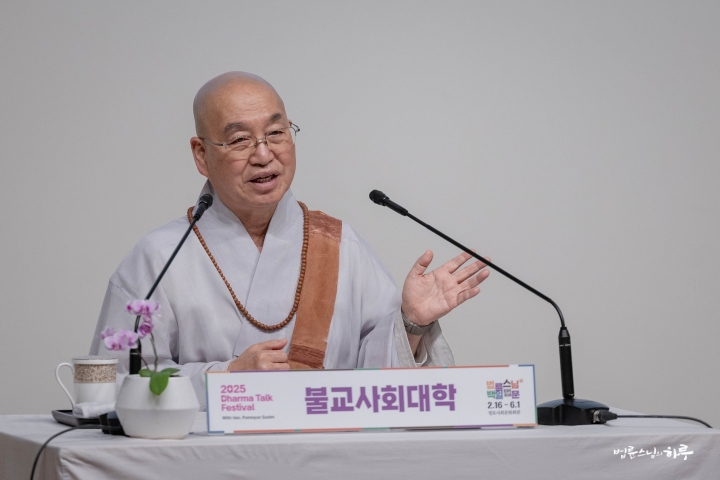
The class concluded after 9 PM, with an agreement to cover the topic “Religious Conflicts and Dialogue in Asia” in the next session.

Tomorrow will be the 89th day of the 100-Day Dharma Talk. In the morning, Sunim will conduct the Friday Dharma Q&A for the daytime session in the main hall of the Jungto Social and Cultural Center basement. In the afternoon, he will attend a meeting about youth movements, followed by an online meeting with the community Dharma teachers. In the evening, after conducting the evening session of the Friday Dharma Q&A, Sunim will travel to the Dubuk Jungto Retreat Center.



